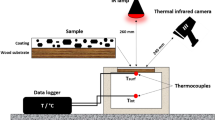Summaries
The exterior durability of a wood-coating is low, especially when it is a protective stain. The severest degradation comes from the dimensional variations of the wood which strains the coating and leads to the formation of cracks. Thus, the service life of a wood coating system con be increased by various means:
-
▀ improvement of the coating flexibility and also by reducing the glass transition temperature (Tg) below the temperature of use.
-
▀ dimensional stabilisation of wood, for which thermal and chemical treatments (acetylation) are efficient, although most of them decrease the wettability of the wood surface and the adhesion of the coating. Polyethylene glycol (PEG) can be used to stabilise wood and con be added directly in the finishing primer.
-
▀ improvement of coating adhesion by a modification of the wood surface. For example, plasma treatments have been applied to wood, with and without thermal treatments, in order to improve its surface properties.
Zusammenfassung
Die Aussendauerhaftigkeit einer Beschichtung zeigt sich als niedrig, besonders wenn es um eine Holzbeize geht. Die heftigste Degradation stammt aus den Veränderungen von den Holzdimensionen, die elastische Deformation der Beschichtung und Rissbildung gibt. Folglich, die Nutzdauer einer Holzschutzbeschichtung lässt sich auf méheren Weisen verbessern:
-
▀ Verbesserung der Beschichtungsflexibilität durch die Verminderung der Glasumwandlungs-temperatur (Tg) bis sie steht niedriger als die Nutztemperatur.
-
▀ Stabilisierung der Holzdimensionen, wo die chemischen Behandlungen (Acetylation) sich wirksom zeigt. Aber meistens sie vermindern die Benetzborkeit der Holzoberfläche und auch die Adhäsion der Beschichtung, Polyethylenglykol lässt sich direkt an der Grundierung hinzufugen.
-
▀ Verbesserung der Beschichtungsadhäsion mittels einer Modifizerung der Holzoberfläche. Plasmavorbehandlung wurden ouf Holz, mit und ohne Warmebehandlung angewandt, um derer Oberfläcßebeigenschafen zu verbessern.
Résumé
La durabilit d’un système bois-finition est faible, d’autant plus si la finition employée est une lasure. Les dégradations les plus importantes proviennent des variations dimensionnelles du bois qui sollicitent le revitement et conduisent à son craquelage. Différents moyens peuvent donc ètre mise en ouvre pour ougmenter la durée de vie du couple bois-finition:
-
▀ oméliorer la souplesse de la finitionen diminuant sa température de transition vitreuse (Tg) sous la température díemploi.
-
▀ stobiliser le bois dimensionnellement. Des troitements thermiques et chimiques (acétylation) sont efficaces mais la plupart dientre eux diminuent la mouillobilité du bois et compromettent l’adhésion d’un revitement. Par contre le polyéthylène glycol (PEG) stabilise le bois et peu être directement ajouté dons le primaire de finition.
-
▀ augmenter l’adhésion de la finition par une modification de surface du bois. Des traitements plasma ont été appliqués ou bois, ovec ou sons pré-traitement thermique, dans le but d’améliorer ses propriétés de surface.
Similar content being viewed by others
References
Podgorski L, Merlin A and Déglise X, Comparison of different kinds of weathering of a wood coating: changes in the glass transition temperature (Tg), Eurocoat 96, Genova,I, 215–228, 1996.
Podgorski L, Merlin A and Déglise X, Analysis of the natural and artificial weathering of a wood coating by measurement of the glass transition temperature, Holzforschung,50, (3) 282–287, 1996.
Fox TG and Flory PJ, Second-order transition temperature and related properties of polystyrene. Influence of molecular weight,J Appl Phys, 21, 581–90, 1950.
Resins for Surface Coatings, Ed Oldring P, Hayward G, 1987.
Rozumek O, Etude de la mouillabilité d’un matériau cellulosique: le bois, Thesis, Université de Haute Alsace, France, 1996.
Girard PH, Dirol D and Viitaniemi P, Upgrading of non durable wood timber by appropriate thermal treatment, Poster,IUFRO conference, Pullman, USA, 1997.
Viitanen H, Jämsä S, Paajanen L, Nurmi A and Viitaniemi P, The effect of heat treatment on the properties of Spruce. IRG Bali- 25th annual meeting — IRG WP — 94-40032, 1994.
Viitaniemi P and Jämsä S, Modification of wood with heat treatment. Espoo, VTT publications 814.57s (in Finnish, English abstract), 1996.
Pizzi A, Stephanou A, Boonstra MJ and Pendlery AJ, A new concept on the chemical modification of wood by organic anhydrides, Holzforschung, 48, Suppl 91–94, 1994.
Rowell RM, Tillman AM and Simonson R, A simplified procedure for the acetylation of hardwood and softwood flakes for flakeboard production,J Wood Chem Technol,6, (3), 427–448, 1986.
Imamura Y, Subiyanto B, Rowell RM and Nilsson T, Dimensional stability and biological resistance of particle-board from acetylated albizzia wood particles, Wood Research, 76, 49–58, 1989.
Roux ML and Podgorski L, Benefit to have tomorrow a European artificial weathering test for wooden coatings. Advances in exterior wood coatings and CEN Standardisation,Paint Research Association Conference, 19–21 October, Brussels, 1998.
Rowell RM and Konkol P, Treatments that enhance physical properties of wood, Forest Products Laboratory, General Technical Report 55, 1987.
Hon DNS, Chang ST and Feist WC, Protection of wood surfaces against photo-oxidation,J Appl Polym Sci, 30, 1429–1448, 1985.
Maury S, Etude de la durabilité du traitement de stabilisation dimensionnelle du bois par le PEG, DEA Sciences du Bois, Université Henri Poincaré, Nancy, 1994.
Xiao GZ, Effects of solvents on the surface properties of oxygen plasma-treated polyethylene and polypropylene films,J Adhesion Sci Technol,11 (5), 655–663, 1997.
Author information
Authors and Affiliations
Rights and permissions
About this article
Cite this article
Podgorski, L., Roux, M. Wood modification to improve the durability of coatings. Surface Coatings International 82, 590–596 (1999). https://doi.org/10.1007/BF02692672
Issue Date:
DOI: https://doi.org/10.1007/BF02692672




